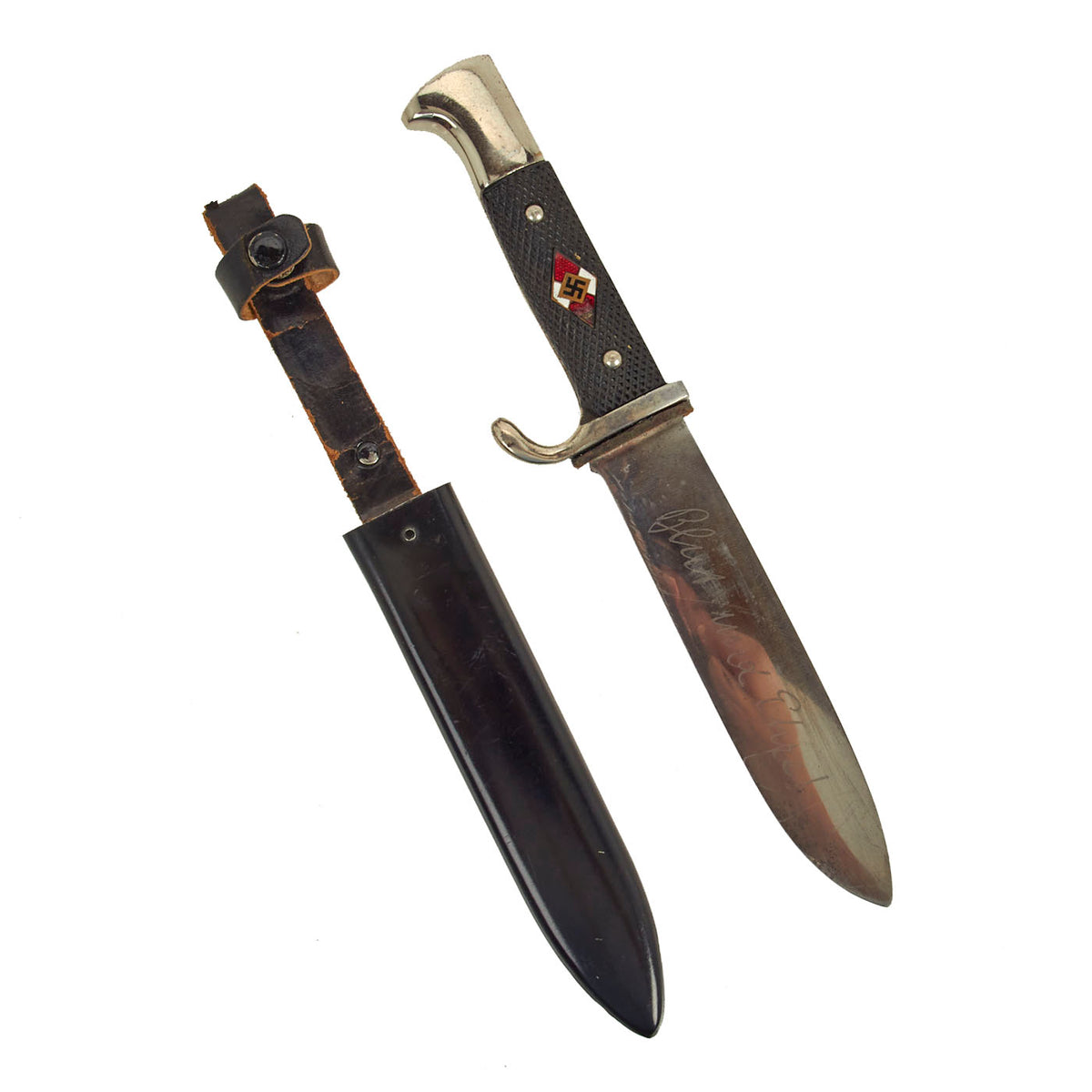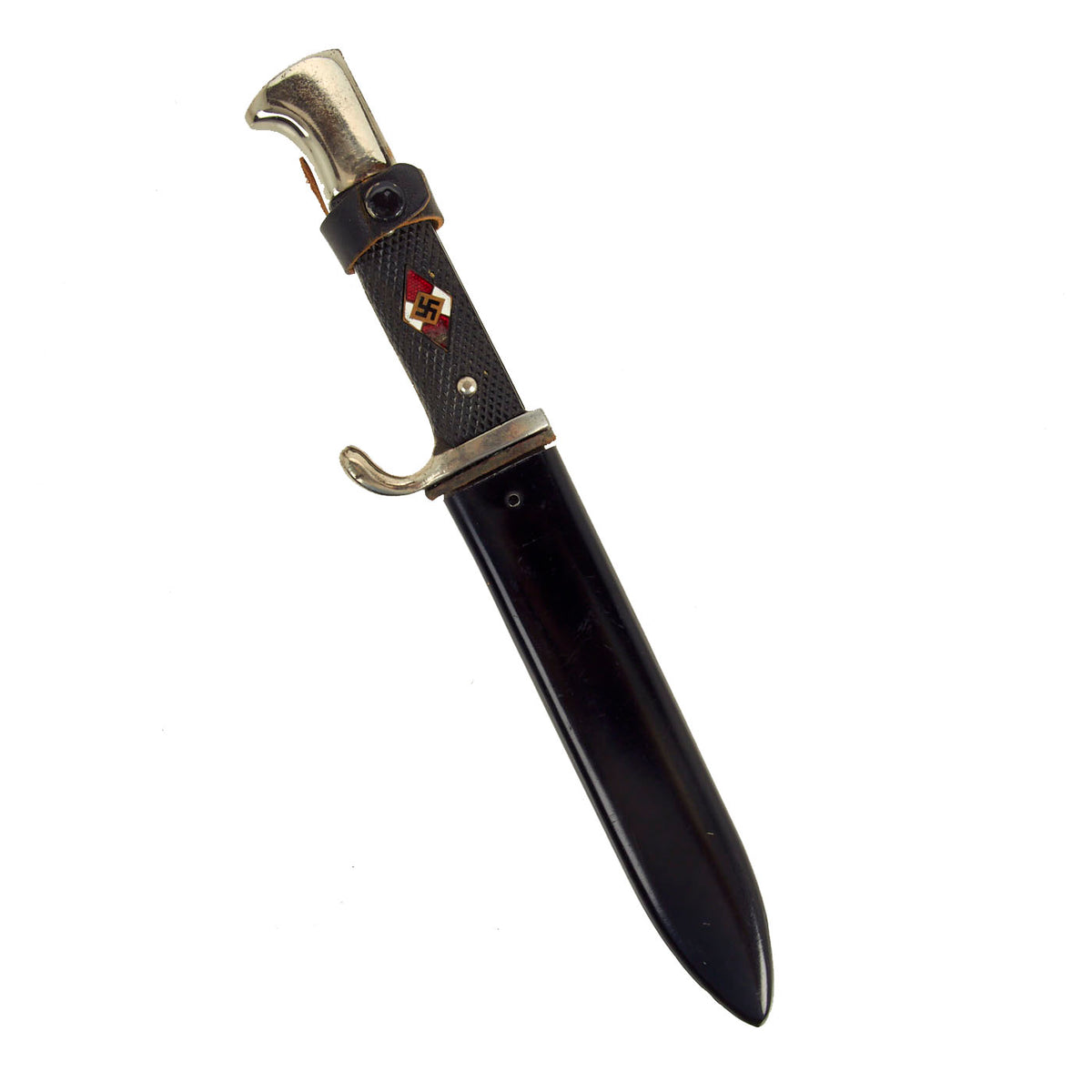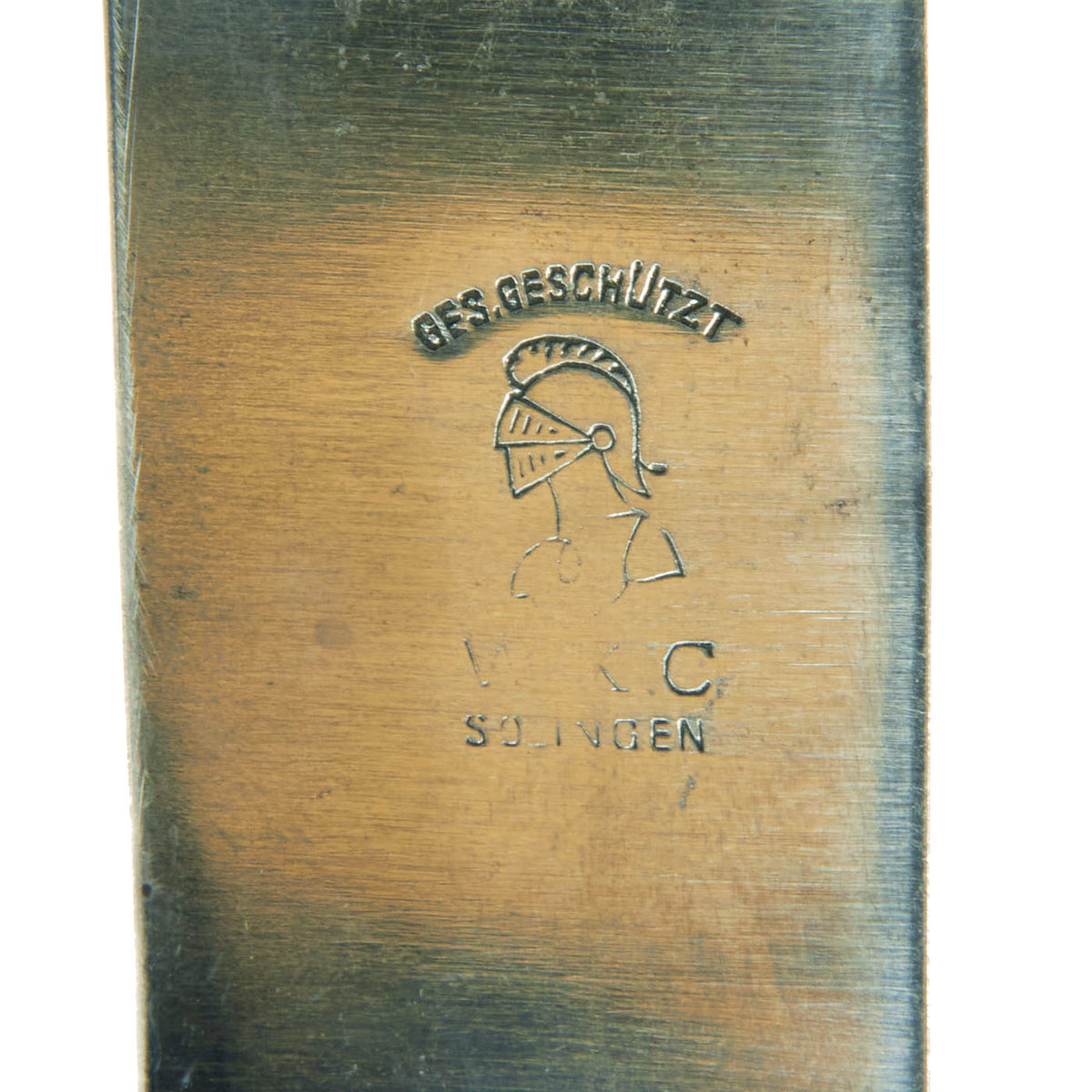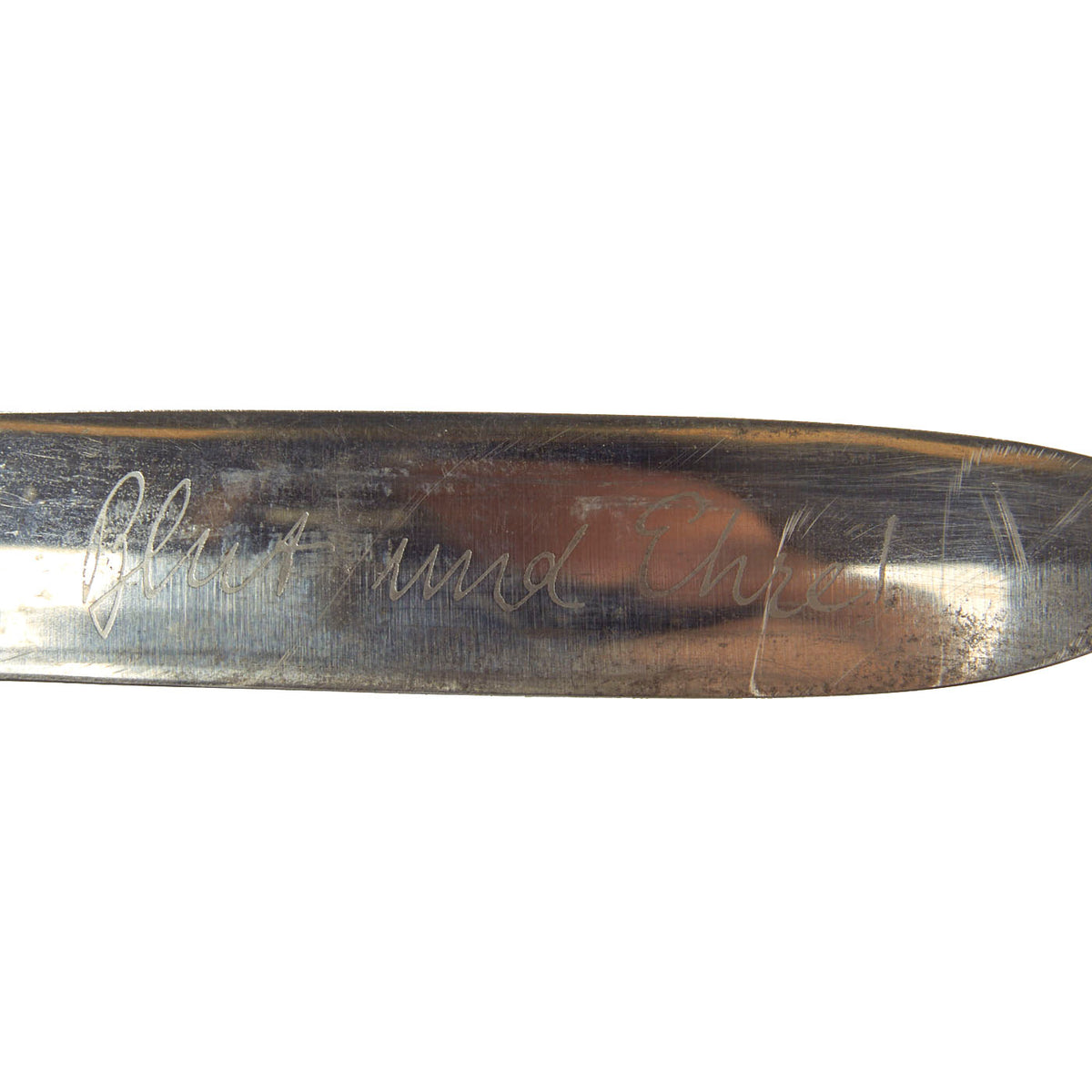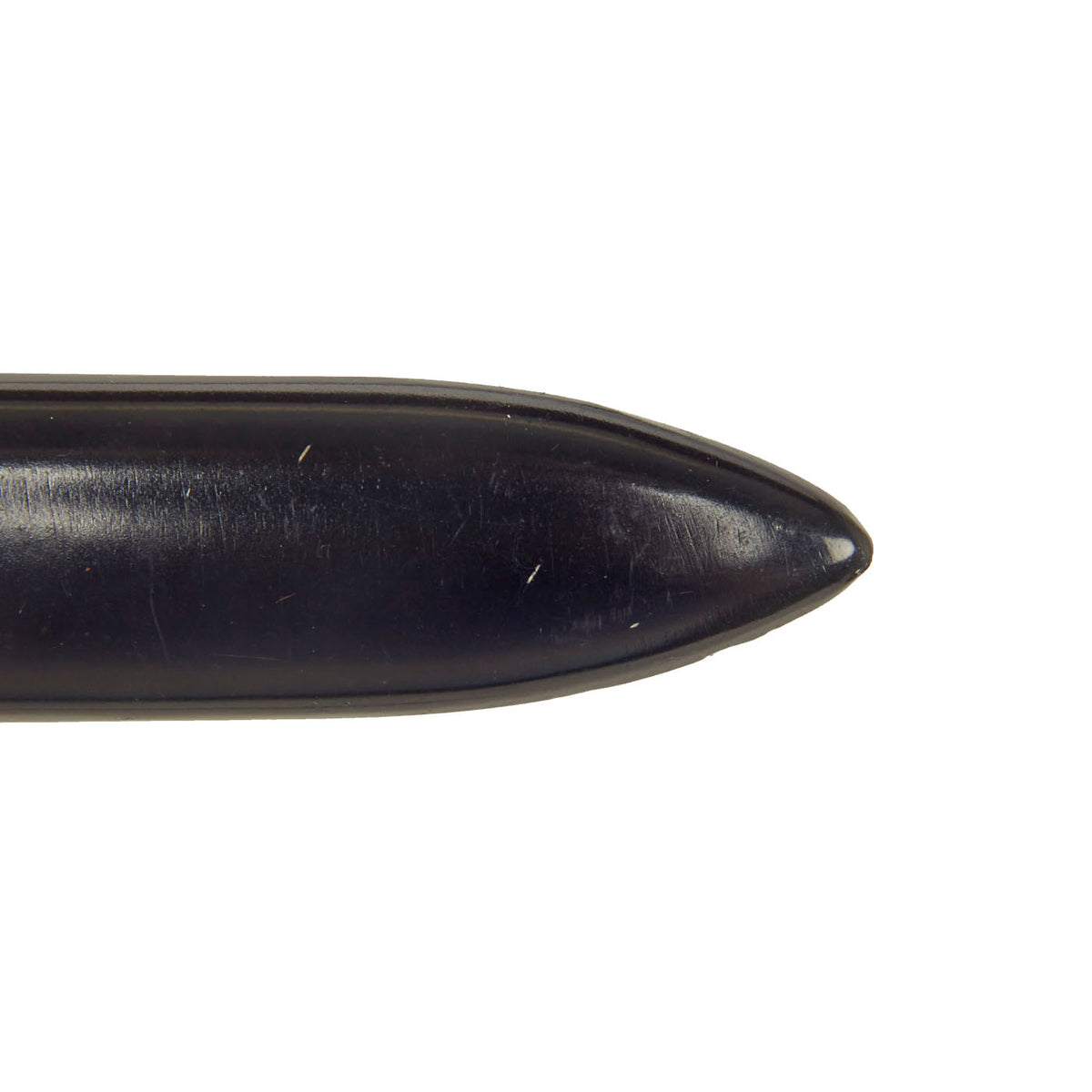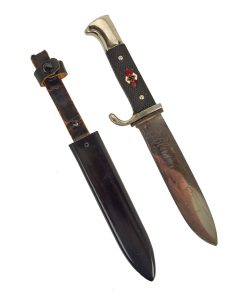Original German WWII Early Motto Marked HJ Knife by Weyersberg, Kirschbaum & Cie of Solingen with Scabbard Original Items
$ 1.095,00 $ 273,75
Original Item: Only One Available. This is a very nice service used condition early HJ Fahrtenmesser (trip knife), marked on the blade with W.K.C. This early HJ Knife is a very good example of the type, showing honest period wear and oxidation to the knife. The plating on the steel hilt is still mostly present, with just a few areas of wear through and light oxidation. The acid-etched motto Blut und Ehre! (Blood and Honor!) is fully present and easy to see, with little to none of the original factory darkening still present.
The Bakelite grip plates are closely checkered and in good condition, retained by nickel rivets with dressed obverse heads. Unfortunately there is a chip in the bakelite just below the crossguard. The HJ insignia is also in good condition with the enamel about 75 percent intact with a piece of the top section cracked and missing. The plating is worn away leaving a lovely oxidized brass patina on the borders. The bakelite shrinks slightly over the years, which is why the emblem on this example is slightly loose, confirming authenticity.
The blade of this example is in very good condition, and is typical of the early period up until 1936. It has a thinner blade with no raised ricasso, and also no RZM codes. Overzealous polishing and cleaning has unfortunately worn away the original factory final grind cross grain, and there is light staining and some scuffing on many areas. The knife has been sharpened several times, however it still retains the original shape. It is currently quite sharp, so it should be handled with care.
The reverse ricasso is maker marked with a trademark “Knight’s Head” logo over WKC / SOLINGEN with GES. GESCHUTZ above. This is the trademark logo used by the sought after maker, Weyersberg, Kirschbaum and Cie, Stahwarenfabrik from the Wald area of Solingen, the legendary “City of Blades” in the mountains of Eastern Germany. The company was founded in 1883 with the merger of two major Solingen sword-making companies, Weyersberg and Kirschbaum. In 1900 the company was the largest in Solingen, employing around 1,200 workers. For more information please see J. Anthony Carter’s fine work GERMAN KNIFE AND SWORD MAKERS. WKC uses traditional hand forging in their production process. The company supplies over 50 militaries, military academies and police forces worldwide with ceremonial swords. The company also makes Japanese Katanas using the traditional hand forging process.
The design of the knife is registered with the German trademark office, indicated by the GES. GESCHÜTZT stamped above the trademark logo, which is short for Gesetzlich Geschützt (Protected by Law). The original leather blade buffer is present and in lovely condition on this example.
The scabbard shell is the typical tapered example and is in very good condition. It has over 99% of the original factory black enamel, and the original texture of the metal underneath can be seen, so it was not refinished. There are just two small areas on the front where the paint is worn away. The leather belt loop is present with an intact securing strap, and is in condition, with some cracking where it meets the scabbard.
A very nice early pattern HJ Knife and scabbard, made by a sought after Solingen maker! Ready to display!
Approximate Measurements:
Blade Length: 5 1/2″
Blade Style: Single Edged Knife.
Overall length: 9 5/8”
Crossguard: 2”
Scabbard Length: 5 3/4”
AH believed German youth to be the future of his 3rd Reich. The HJ (AH Jugend) was formed officially in 1935, and with the exception of NSDAP ideology indoctrination was very similar to the Boy Scouts. Beginning at about the age of ten years, both boys (AH Jugend) and girls (Bund Deutscher Mädel) were enlisted in the Party-run organization. The boys only were given HJ Knives after having passed minor exams. The knives had nickeled hilts with black checkered grip plates. The obverse plate was fitted with an enameled HJ swas insignia. Through 1937, these knives were etched with the motto of the organization, Blut und Ehre! (Blood and Honor!). Examples produced after this date were made with plain blades usually bearing an RZM marking.
The HJ Leaders were professionals in charge of the training and NSDAP education of the German Youth. They wore a special dagger consisting of silvered hilt fittings with blue-black leather-covered scabbard. The grip was composed of tightly wrapped silver wire, over a wood base. The pommel cap featured an HJ diamond on top, complete with swas. The upper scabbard fitting portrayed an open-winged HJ eagle with swas cut into the bird’s chest. The blade was etched with the HJ motto, Blut und Ehre!
Fast Shipping with Professional Packaging
Thanks to our longstanding association with UPS FedEx DHL, and other major international carriers, we are able to provide a range of shipping options. Our warehouse staff is expertly trained and will wrap your products according to our exact and precise specifications. Prior to shipping, your goods will be thoroughly examined and securely secured. We ship to thousands clients each day across multiple countries. This shows how we're dedicated to be the largest retailer on the internet. Warehouses and distribution centres can be located throughout Europe as well as the USA.
Note: Orders with more than one item will be assigned a processing date depending on the item.
Before shipping before shipping, we'll conduct a thorough inspection of the items you have ordered. Today, the majority of orders will be delivered within 48 hours. The delivery time will be between 3-7 days.
Returns
The stock is dynamic and we cannot completely manage it because multiple stakeholders are involved, including our factory and warehouse. So the actual stock may alter at any time. It's possible that you may not receive your order once the order has been made.
Our policy is valid for a period of 30 days. If you don't receive the product within 30 days, we are not able to issue a refund or an exchange.
You can only return an item if it is unused and in the same state as the day you received it. You must have the item in its original packaging.
Related products
Uncategorized
Uncategorized
Armoured Fighting Vehicles of the World: AFVs of World War One (Hardcover Book) New Made Items
Uncategorized
Band of Brothers ORIGINAL GERMAN WWII Le. F.H. 18 10.5cm ARTILLERY PIECE Original Items
Uncategorized
Uncategorized
Uncategorized
Uncategorized
Uncategorized
Uncategorized
Uncategorized
Uncategorized
Uncategorized
Uncategorized
Uncategorized
Uncategorized
Uncategorized
